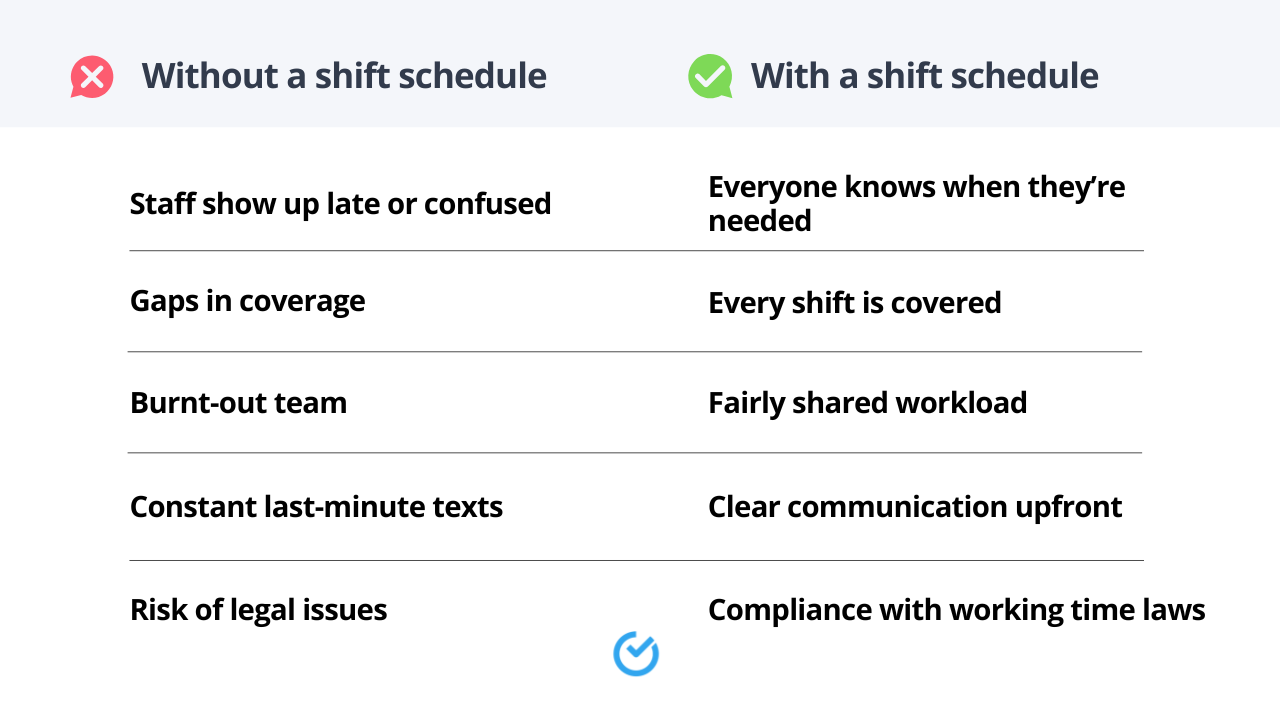In this guide, we’ll break down everything employers need to know about shift schedules—what they are, how they work, and how to make them work better for your business.
What is a shift schedule?
A shift schedule is basically your game plan for who’s working when. It shows which employees are covering which hours or days, especially in workplaces that run beyond the classic 9 to 5; like restaurants, hospitals, warehouses, or retail.
Instead of everyone clocking in at the same time, shifts let you spread coverage across mornings, afternoons, nights, weekends, or even 24/7.
Why are shift schedules important
Getting your shift schedule right is more than just filling hours. It helps you:
- Keep the business running smoothly with the right number of people
- Avoid staff burnout and last-minute no-shows
- Stay legally compliant (especially with laws around rest time and working hours)
- Give employees better work-life balance (hello, happy team!)

Types of shift schedules
Not all shift schedules are created equal. The right one depends on your industry, how many hours you need covered, and how flexible your team can be.
Here are the most common types:
Fixed shifts
Employees work the same hours on the same days, every week. Predictable and easy to manage; great for teams that like routine.
- Example: Sarah works 9am–5pm, Monday to Friday, every week.
- Best for: Offices, admin roles, or stable retail hours.
Rotating shifts
Employees switch between different shifts (e.g. mornings one week, evenings the next). Fair, but can be tough on work-life balance if not handled well.
- Example: Week 1 = early shift, Week 2 = late shift.
- Best for: Warehouses, hospitals, customer service centres.
Split shifts
One shift is divided into two parts with a long break in between. Useful when there are busy periods (like lunch and dinner rushes).
- Example: 10am–2pm and 6pm–10pm.
- Best for: Hospitality, transport, delivery services.
On-call shifts
Staff are available to work if needed, but not guaranteed hours. Needs careful handling to avoid burnout and legal issues.
- Example: Emergency maintenance staff or health care backups.
- Best for: Medical, tech support, emergency services.
2-2-3 schedule
A newer pattern where employees work 2 days, off 2 days, then work 3 days (and alternate the next week).
- Example: Sun–Mon work, Tue–Wed off, Thu–Sat work.
- Best for: 24/7 coverage with longer rest periods.
Four-day workweek
Employees work four longer days and get a consistent day off. More companies in the UK are testing this, without cutting pay.
- Example: 10-hour days, Monday to Thursday.
- Best for: Office-based or hybrid teams who value focus time.
Continental shift
Employees work a mix of day and night shifts (also known as third shifts) across a set cycle, often over 7 days, then get days off. It covers 24/7 operations without requiring overtime.
- Example: 2 day shifts, 2 night shifts, 2 days off.
- Best for: Manufacturing, utilities, emergency services.
DuPont schedule
A complex 4-week rotating system that mixes 12-hour day and night shifts with blocks of days off, designed for high coverage with regular long breaks.
- Example: Week 1 = 4 nights on, 3 off; Week 2 = 3 days on, 1 off...
- Best for: Industrial jobs that need 24/7 coverage with fewer staff.
Pitman schedule (or 2-2-3 variant)
This is similar to the 2-2-3, but with 12-hour shifts. Employees get every other weekend off, and often work 14 days a month.
- Example: Work 2 days, off 2, work 3, then reverse.
- Best for: Police, security, healthcare.
Flexi-time (flexible hours)
Rather than fixed start/finish times, employees choose when they begin and end work within agreed limits which is great for morale and productivity.
- Example: Must work 8 hours between 7am–7pm, but can start at 8:30 and finish at 4:30.
- Best for: Office-based or remote teams, especially with hybrid working.
Staggered shifts
Staff start and finish at different times, helping reduce overcrowding (or commuting during rush hours). Everyone works the same total hours.
- Example: Team A = 7am–3pm, Team B = 9am–5pm, Team C = 11am–7pm.
- Best for: Contact centres, logistics, factories, or hybrid offices.
What is the best shift work schedule?
There’s no one-size-fits-all answer, but here’s the simple truth: 👉 The best shift schedule is the one that works for your business AND your people.
It should:
- Cover all your operating hours
- Keep your team healthy, happy, and showing up
- Stay compliant with working time laws
- Be easy to manage without spreadsheets eating your Sunday
How to choose the right shift schedule
Your shift schedule needs to fit your business, your team, and how your days actually run. Get it wrong, and you’re left with confusion, burnout, or staff quitting.
So here’s how to get it right, without overcomplicating things.
Step 1: Know your coverage needs
Ask yourself:
- What hours does your business need to be open?
- Do you need weekend or evening coverage?
- Are there peak hours that need extra staff?
💡 Tip: Look at past rotas or sales data. When are things busiest?
Step 2: Understand your team
Get a feel for what your employees need and want. Consider:
- Who prefers mornings vs evenings?
- Who has care duties, second jobs, or commutes?
- Who needs more stability vs flexibility?
It’s worth asking them directly; you’d be surprised what a quick survey can reveal.
Step 3: Factor in legal requirements
Make sure your shift schedule complies with:
🇬🇧 UK law (Working Time Regulations):
- Maximum 48 hours per week (averaged over 17 weeks)
- 11 hours’ rest between shifts
- At least one 24-hour rest period each week
- Minimum 20-minute break if working 6+ hours
- Night workers have special limits and health checks
⚠️ You can offer opt-out agreements, but they must be voluntary and written.
Step 4: Balance consistency and flexibility
Some staff like predictability (fixed shifts). Others prefer freedom (flexi-time or self-scheduling). Can you offer a mix?
👉 Example: Use fixed shifts for full-timers and rotating shifts for part-timers.
Step 5: Test and adjust
No schedule is perfect on day one. Setup trial shifts and try it for a few weeks, then:
- Ask your team for feedback
- Watch for issues like too many short rest periods or uncovered shifts
- Tweak as needed
✅ The goal? A schedule that works for everyone, without constant chaos.
Best practices for shift scheduling
A good shift schedule keeps your business running like clockwork. A bad one? Expect missed shifts, burnt-out staff, and constant WhatsApps at 10pm. Here’s how to get it right the first time:
Plan ahead (but not too far)
Give staff at least 2 weeks’ notice of their shifts. It’s not just respectful—it’s becoming law in more places (e.g. Scotland is pushing for predictable scheduling rights).
Why it matters:
- Gives employees time to plan their lives
- Reduces no-shows and rota swaps
- Keeps you legally covered
Be consistent with patterns
Where possible, use repeatable shift patterns. Constant changes confuse everyone and make it hard to settle into a rhythm.
👉 Example: Same shift every Monday and Wednesday, rotating Fridays.
Keep it fair
Avoid scheduling the same people for all the awkward shifts (nights, weekends, bank holidays). It breeds resentment and resignations.
Use your scheduling tool to:
- Track who’s worked what
- Rotate high-demand slots
- Offer voluntary swaps
Use the right tools (ditch Excel already)
Modern scheduling software saves hours and reduces mistakes. It helps you:
- See gaps and conflicts instantly
- Let employees view and swap shifts
- Stay compliant with working time rules
Look for features like:
- Drag-and-drop shift builder
- Overtime and availability tracking
- Payroll integration
Include buffers and breaks
Leave space between shifts, especially for night workers. UK law requires 11 hours of rest between shifts, but it’s also just the humane thing to do.
💡 Tip: Don’t forget legally required breaks (20 mins for shifts over 6 hours).
Communicate clearly and early
Send out shift updates via email, app notifications, or even Slack—whatever your team actually checks. And always confirm swaps in writing.
A quick “Shift confirmed 👍” message avoids a lot of last-minute drama.
How Shiftbase helps you schedule smarter
Building shift schedules manually is a pain. Between juggling availability, tracking overtime, covering last-minute absences, and staying compliant, it’s easy to spend hours tweaking Excel sheets… only to end up with frustrated staff and missed shifts.
That’s where Shiftbase comes in.
It’s a smart, all-in-one tool for workforce management that makes creating, sharing, and adjusting shift schedules fast and stress-free.
Here’s how it helps:
- With employee scheduling, you can build rotas in minutes, see who’s available in real-time, and avoid conflicts or understaffing
- The built-in time tracking tool keeps everything accurate, from start times to breaks and overtime
- Absence management lets you track sick days, holidays, and last-minute call-ins without chasing people on WhatsApp
It’s perfect for managers who want more control, and teams who want more clarity.
👉 Want to see what a stress-free shift schedule feels like? Try Shiftbase free for 14 days—no strings, no credit card, just smarter scheduling.


